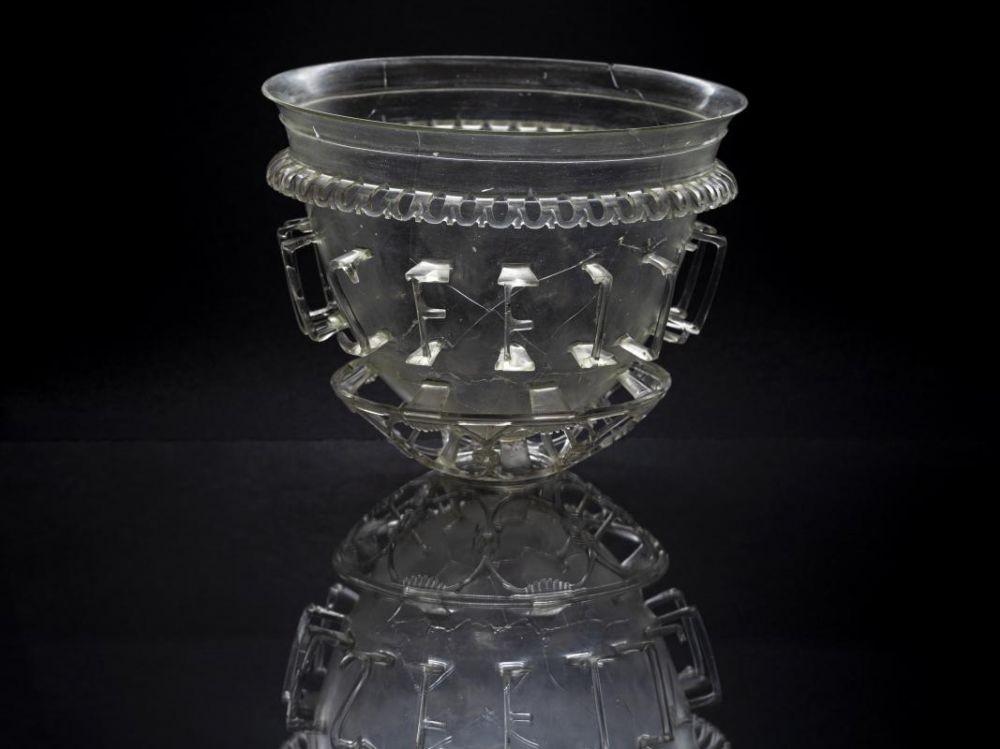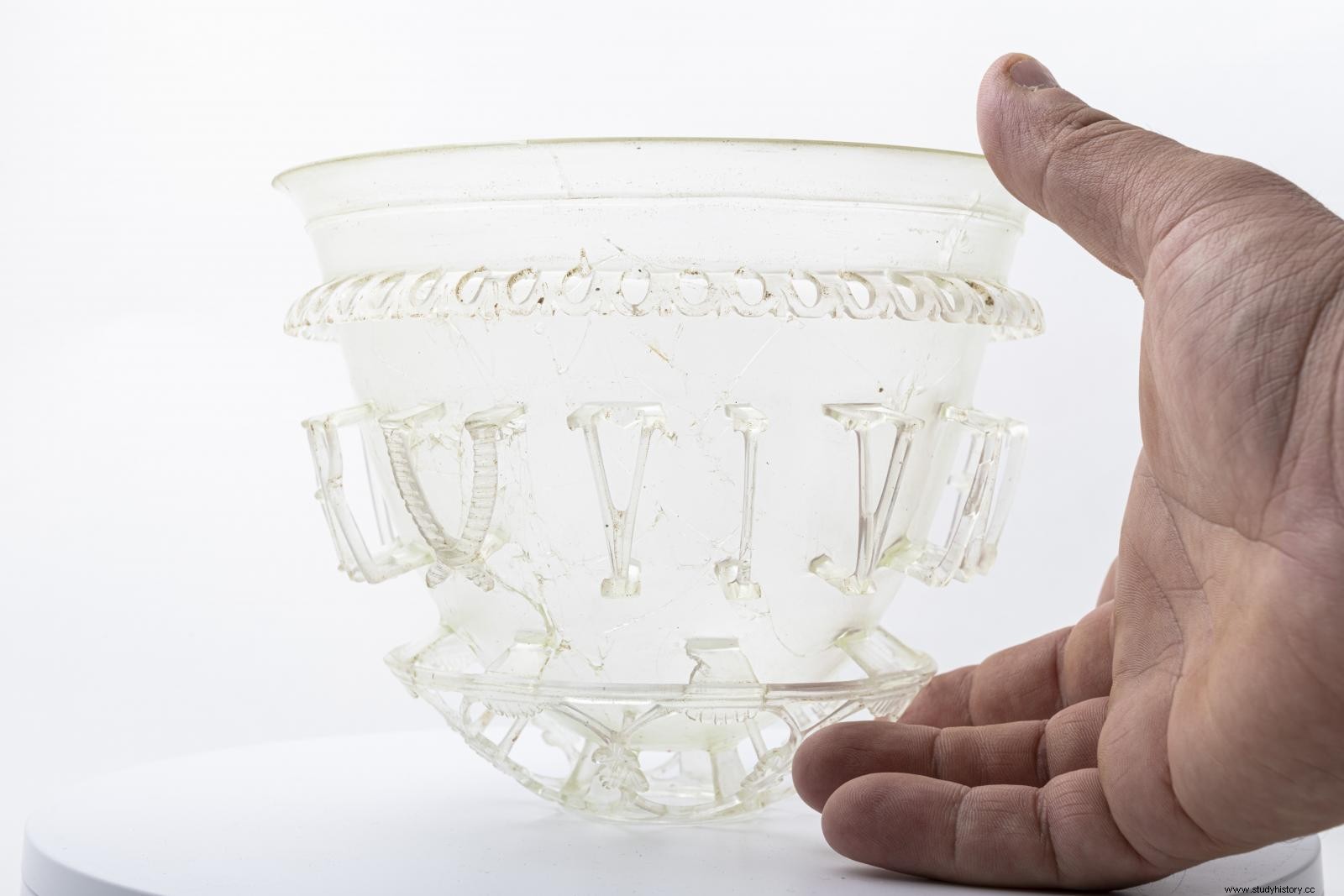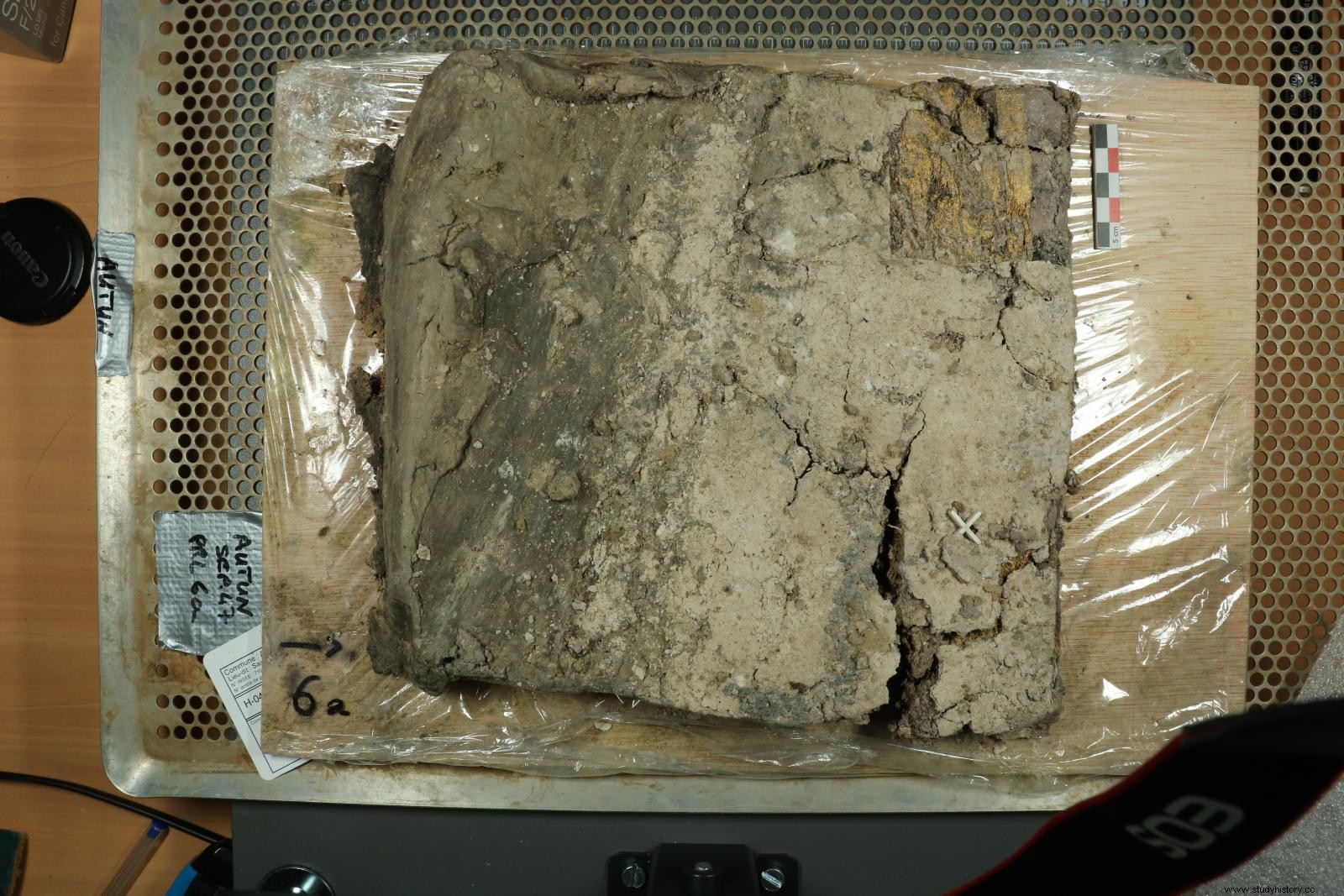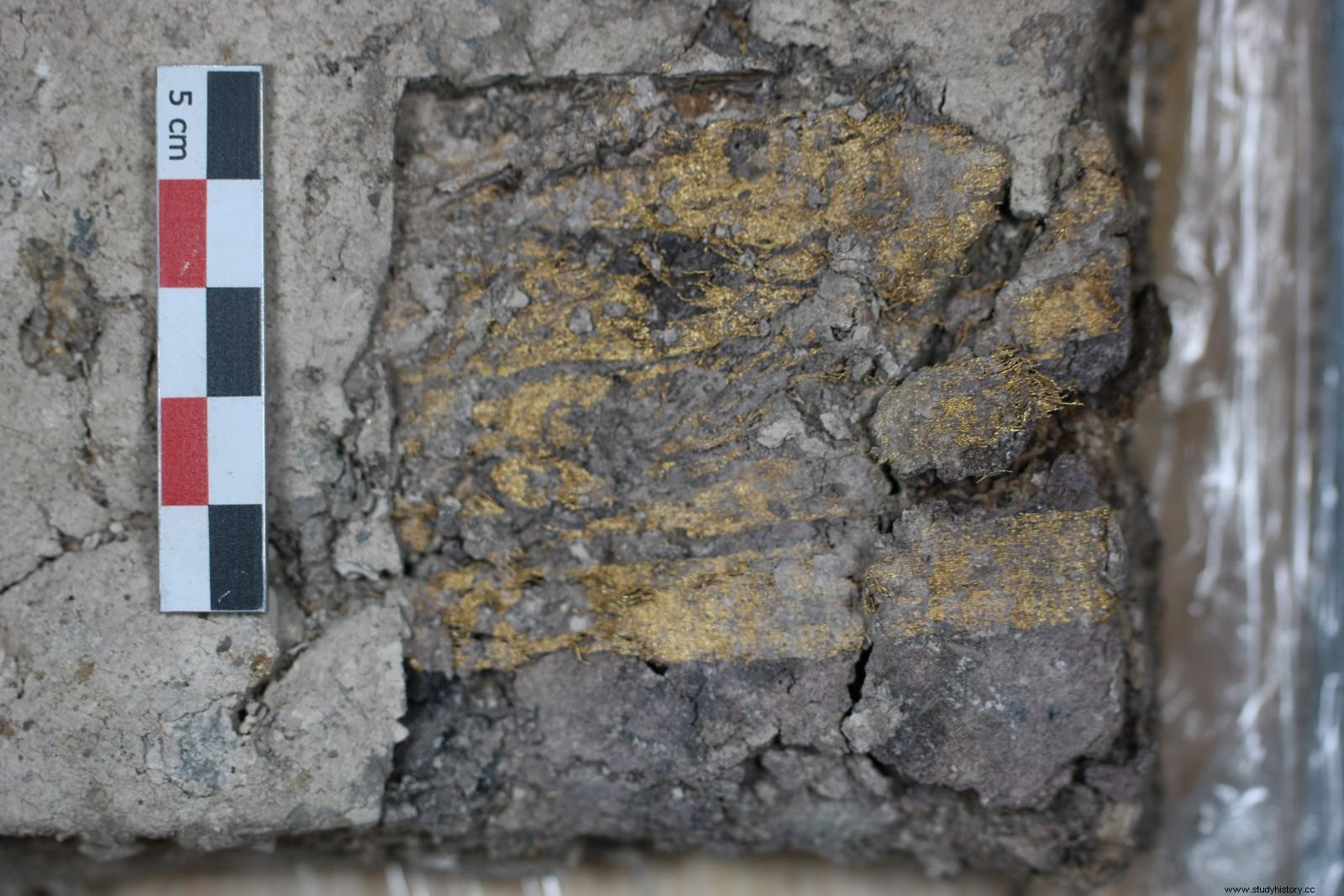This vase carved from a single block of glass, dating from the very end of Antiquity, had been found crushed but complete in a tomb in Autun, in Saône-et-Loire. Exceptional in its rarity, it has just been restored to its former glory after a delicate restoration. But today its content, just as extraordinary, intrigues archaeologists.

The reticulated glass diatrete vase dated from the 4th century, found in a tomb in Autun, after its restoration.
It only took a short year for the remarkable ornate glass vase discovered in the summer of 2020 in a necropolis in Autun, in Saône-et-Loire, to regain its original shape and sumptuousness. It must be said that he couldn't wait:once this type of object is out of the ground, you have to act quickly before humidity or temperature variations degrade it irreversibly.
Entrusted in February 2021 to the expert hands of Katja Broschat, restorer at the Central Roman-Germanic Museum (RGZM) in Mainz, Germany, it has therefore just returned to Autun, this time well protected in the reserves of the museum of the city for its future exhibition. This exceptional piece, both for its state of preservation and for its technical virtuosity, is what is called a "diatrete" vase, or caged glass. A ceremonial vessel whose lace-like ornaments have been carved into the section of glass itself, giving the impression that the vessel rests in a crystalline cage.
An enigmatic object
Produced at the end of the Roman period, around the 4th century AD, the diatretes are real archaeological rarities:there are only 13 complete examples worldwide, of which a tiny portion has been discovered in an archaeological context. . This one, which rested alone at the feet of the deceased in one of the 230 burials of the necropolis, is the very first found in Gaul. It is assumed that it was installed on a device that no longer exists, such as a cushion or a small wooden table that ensured its stability.

The mud when it was discovered, in the summer of 2020. Credits:Bérénice Btend-Desgranges/Inrap
It only took a short year for the remarkable ornate glass vase discovered in the summer of 2020 in a necropolis in Autun, in Saône-et-Loire, to regain its original shape and sumptuousness. It must be said that he couldn't wait:once this type of object is out of the ground, you have to act quickly before humidity or temperature variations degrade it irreversibly.
Entrusted in February 2021 to the expert hands of Katja Broschat, restorer at the Central Roman-Germanic Museum (RGZM) in Mainz, Germany, it has therefore just returned to Autun, this time well protected in the reserves of the museum of the city for its future exhibition. This exceptional piece, both for its state of preservation and for its technical virtuosity, is what is called a "diatrete" vase, or caged glass. A ceremonial vessel whose lace-like ornaments have been carved into the section of glass itself, giving the impression that the vessel rests in a crystalline cage.
An enigmatic object
Produced at the end of the Roman period, around the 4th century AD, the diatretes are real archaeological rarities:there are only 13 complete examples worldwide, of which a tiny portion has been discovered in an archaeological context. . This one, which rested alone at the feet of the deceased in one of the 230 burials of the necropolis, is the very first found in Gaul. It is assumed that it was installed on a device that no longer exists, such as a cushion or a small wooden table that ensured its stability.

The mud when it was discovered, in the summer of 2020. Credits:Bérénice Btend-Desgranges/Inrap
Although exhumed very fragmented, it presented all the elements necessary for its complete restoration. A work of extreme meticulousness, its dimensions not exceeding 15 cm in diameter for barely 13 cm in height. Despite everything, no letter of the Latin inscription that it displays in relief all around – "Vivas Feliciter" ("Live in bliss") -, is not missing. Not even its astonishing defect:the letter C added later, probably the result of a slight "failure" in manufacturing which clashes with its milky appearance. Again, such an inscription finds only rare comparisons in the ancient world, "at least on this type of object", explains Carole Fossurier, scientific manager of the excavation and archaeo-anthropologist. "We originally thought it was 'drinking formulas' as found on tavern goblets of the time, phrases such as ' Bibere Felix' ('Happy to drink'). But the context here is quite different. This is the tomb of a prestigious individual, perhaps suggesting that the use of the vase was diverted to give it a religious symbolism."
The use of diatretic vases, precisely, remains to this day very mysterious for archaeologists. For sure, they were linked to personalities close to the imperial power. Were these diplomatic gifts? Objects related to the Council of Bishops? "One can imagine that they were offered to the bishops at the end of the council, or that the bishops themselves wished to offer themselves this kind of vases once they returned home. But all this remains very hypothetical, because no text mentions such practices" , advances cautiously Carole Fossurier. With lip service, she still allows herself an opinion:"I think the content was more important than the container."
Amber gray
And for good reason:in the vase found in Autun, impregnation analyzes made it possible to highlight the ingredients of a mixture with which it was filled at the time of burial. A mixture of oils, plants and flowers were thus detected, but above all ambergris, or whale amber, an extremely rare and precious product which is none other than the intestinal concretion of a sperm whale. According to Thierry Buquet, researcher at the Center for Ancient and Medieval Archaeological and Historical Research (Craham) and specialist in the history of the substance, the oldest mention of ambergris dates back to the turn of the 5th and 6th centuries, in a Greek physician named Aetius of Amida. Therefore, our diatrete vase becomes the oldest archaeological evidence of the use of this exceptional substance! Aetius d'Amida evokes whale amber as the component of a recipe for "nard", a perfume intended for the church. Collected on the beaches, it would have been used as a binder for this type of fragrance.

But what does this extraordinary container and content tell us about the individual who lay with it? That he is none other than one of the first bishops of France? "It's tempting to say so, but we still have too few elements to confirm it", tempers Carole Fossurier. Still, the old texts tell us that the first bishops of Autun were buried in this vast funerary space of 3 hectares. As for the bones of the character, they will, alas, speak no more:very fragmentary, they no longer contain enough collagen to hope for a carbon-14 dating.
The largest piece of gold cloth
According to the first elements from more than 230 excavated tombs, the necropolis functioned from the beginning of the 3rd century until the middle of the 5th century, with a majority of tombs dating from the 4th century. It is near the paleo-Christian church of Saint-Pierre-l'Estrier, one of the oldest in Europe. While some of the deceased were among the early Christians of Gaul, individuals from other ancient religions appear to be buried there, as indicated by traces of a libation – a liquid offering made of wine, olive oil or milk – found in some burials.
In November 2020, the discovery of about fifteen lead coffins, six stone sarcophagi but also small prestigious furniture had been unveiled by Inrap. Among these pieces of furniture, in addition to the vase, had been found a gold ring and earrings, jet bracelets or even astonishing pins in pure amber, the likes of which are unknown in the Roman world. But another find, almost as exceptional as the vase, can now be added to this list:that of the largest piece of gold cloth ever to come down to us.


"If we had found residues of gold threads in six graves, it was with great surprise that we came across a very large piece of cloth, one or two square meters, in one burials. A dimension like this is never seen for cloth of gold" , enthuses Carole Fossurier. This is reminiscent of the rich fabrics of Paleo-Christian iconography, such as those represented on the mosaics of San Vitale in Ravenna (the figures surrounding the Empress Theodora wear clothes sewn with gold threads ). Undoubtedly wrapped around a body as a shroud, the textile remains for the moment prisoner of the earth in which it was deposited more than 1,500 years ago. Carole Fossurier, who is currently seeking funding for its restoration, hopes that it will soon experience the same fate as the diatrete vase:a rebirth.
